Insular dwarfism is an interesting evolutionary phenomenon where a population of animal that find themselves marooned, separated from main landmass, start evolving progressively into smaller forms or size than what is seen on their ancestors in the mainland to adapt to their newfound restricted reality.This adaptation ensures that these population of animals did not outstrip the limited available food and territory renounces. Causes for this isolation could be impassable barrier such as mountain ranges or more commonly vast oceans.
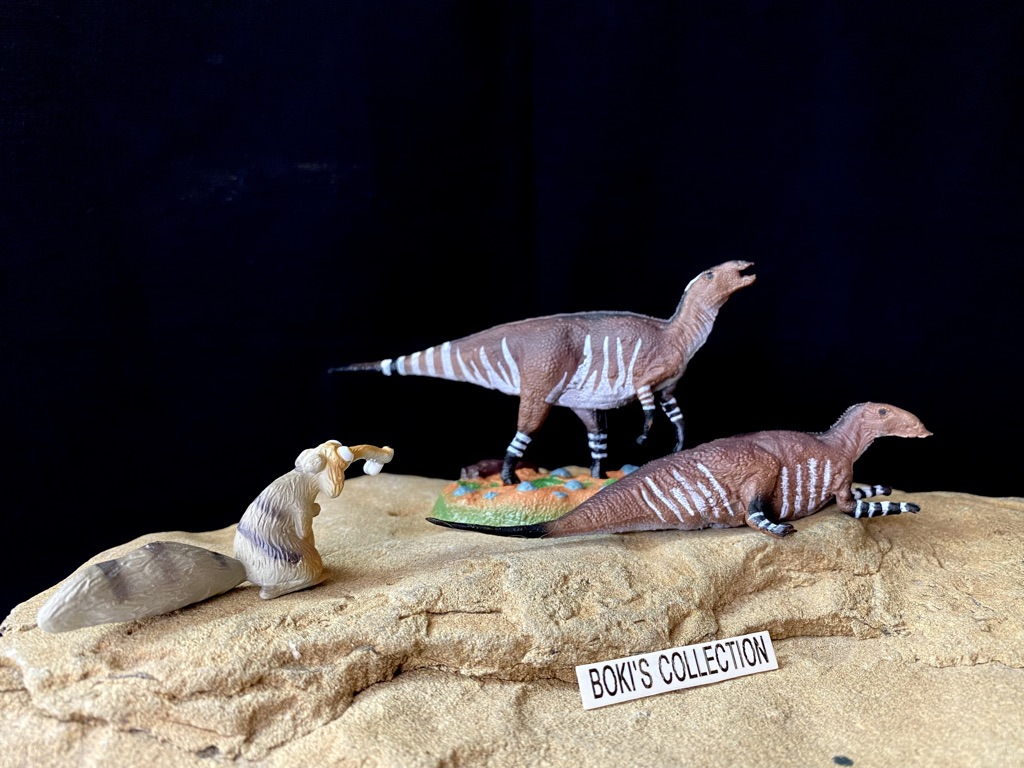
The Tethys Sea was a vast ocean during the Mesozoic that famously separated the continents of Gondwana and Laurasia. In between are countless smaller landmasses and islands that harbored unique dinosaur. Perhaps the most well-known example of insular dwarfism is the fauna assemblage of Hateg Island in what is today Romania. Back in the late Cretaceous it was an island and was famous for its “dwarf “dinosaurs.
Today we will review a delightful pair of Tethyshadros insularis (Tethys hadrosaur), a small hadrosaur from Italy. This obscure little dinosaur is courtesy of Wild Past, a small company based in Germany. For a small startup company, the choice of an obscure species for their second release is both surprising (in a very good way) as well as commendable.The first figure from Wild Past was a Protoceratops released in 2020, an iconic yet underrepresented dinosaur. While other up and coming brands have gone with more well-known genus like those toothy theropods (looking at you Mr. Rex and Spino) as a sure sell as their first figure release, Wild Past seems determined to give some of the lesser-known species a chance at the spotlight.
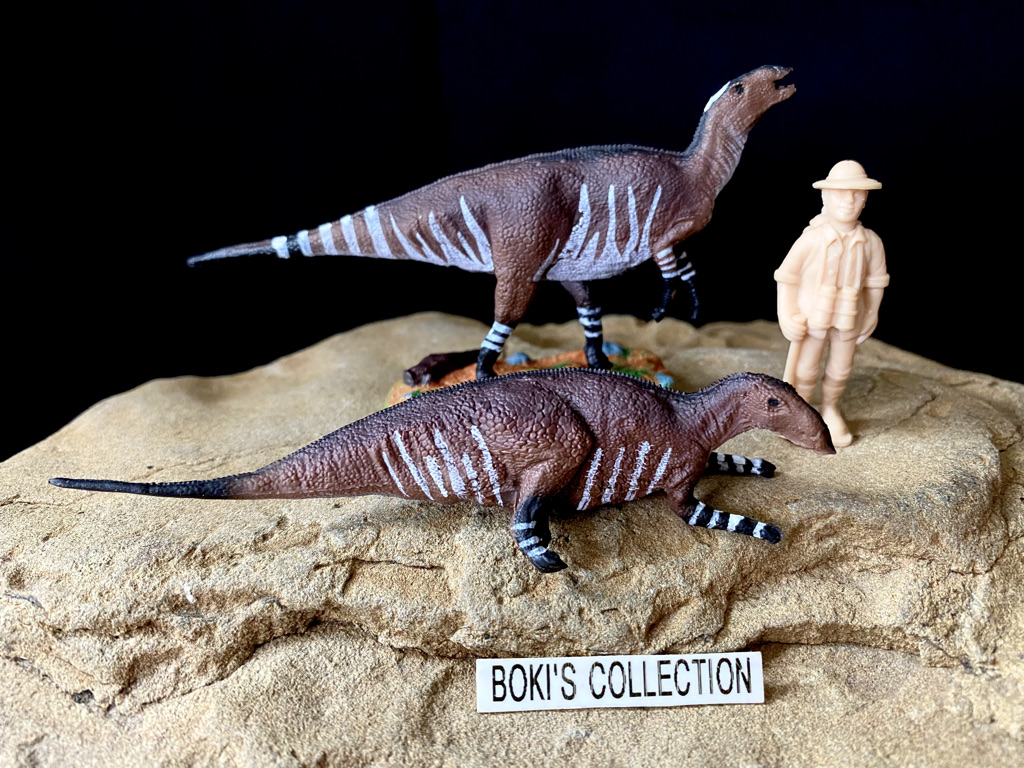
The release of this pair of Tethyshadros was highly anticipated by members of the DTF community not just because of its obscurity, but also a sort of pride, after all, the founders are also members there and have received feedbacks and engagements from the community. The figures are designed and sculpted by Stefan Klein and started as a hobby but soon evolved into a more professional, as well as international company. Like their protoceratops figure, these pair are sculpted in the 1:35 scale, and I believe also done digitally instead of the classic master sculpt ( I could be wrong). This scale size has emerged as the new preferred scale for today’s majority of brands, quickly replacing the one time favorite 1:40. This makes these figures compatibles with models from other brands, this is especially important for those of you who prefer your collection to be at the same scale.
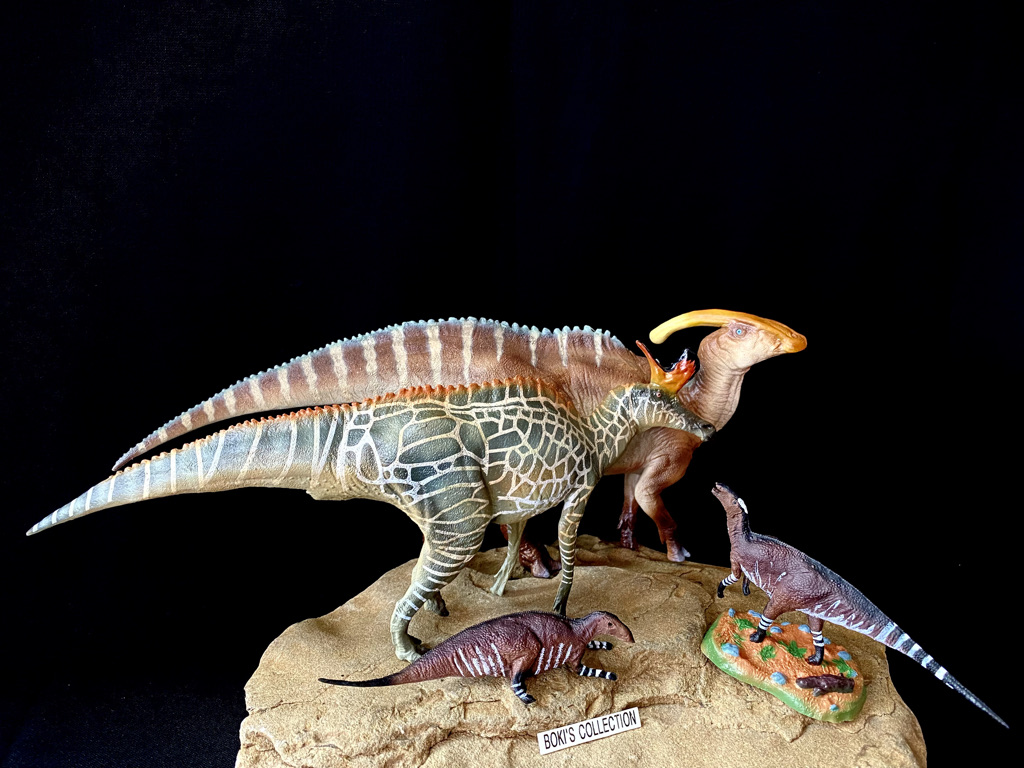
Hadrosaurs are some of the largest dinosaurs despite being placid in nature with some growing to enormous size that rivaled some sauropods. Some species attained fame by their unique appearance, most notable their flamboyant head crest and that famous “duck-bill”. Those that that met these characteristics have gone one to be some of the most famous dinosaur. For others, especially those lacking big size and outlandish head ornamentation, they have faded into obscurity, often lumped into the generic plant eating quadruped that were the favored prey items for large theropods.
What sets Tethyshadros apart is its small size, at least when compared to some of its relatives. Once upon a time, large ancestors of Tethyshadros found themselves isolated and stranded, cut off by the surrounding seas. During the Mesozoic, what we know today as Europe was not yet a huge landmass as it is now. Back then, the mighty Tethys Sea dominated, and the landmass were broken into random archipelagos. As the sea levels rose and fell, some population of animal would find themselves stranded. Such isolation would cause some animals to evolve into smaller forms (insular dwarfism) in response to this new reality. Such was the case for Tethyshadros.
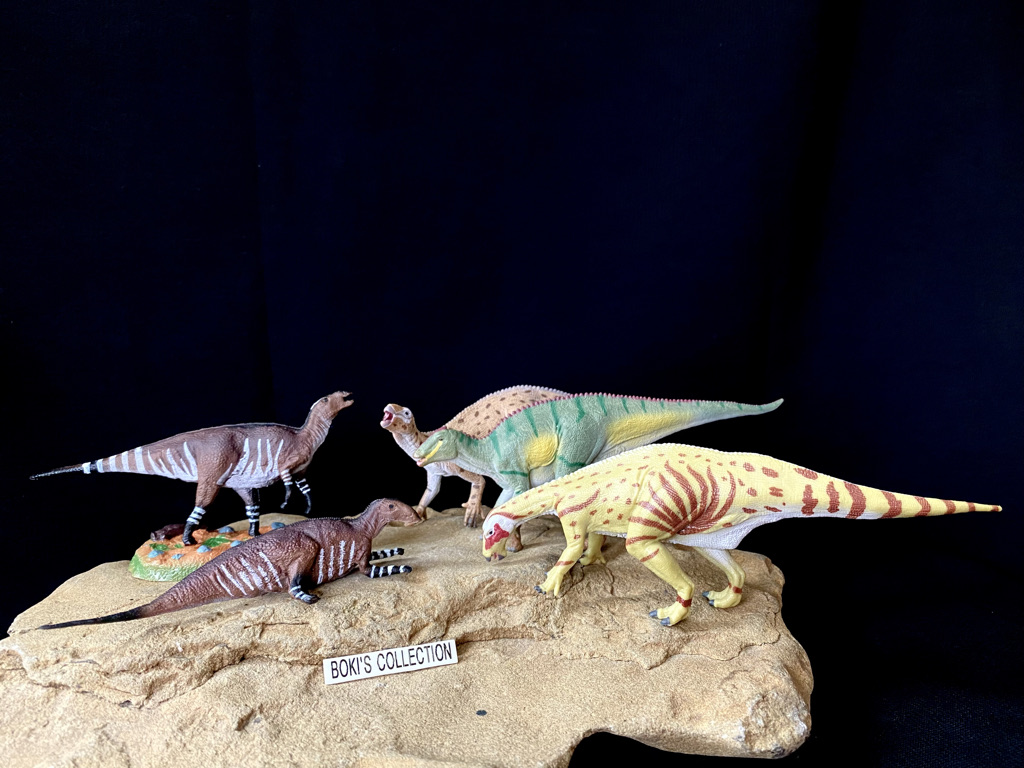
The fossil was first excavated in the late 1990’s and would take many years of careful preparation before being officially named and described in 2009. It was one of the most complete dinosaur fossils found in Europe. The holotype is believed to be and adult animal with an estimated size of around 15′ feet long.
Tethyshadros is unique in that its anatomy is intermediary when compared to others, it possesses unique mixture of primitive features as well as more advanced.Its more primitive features in a lot of ways resembles some of its earlier relatives such as iguanodon in its skull shape and short neck, while its more advanced features such as its hands and teeth which show the more typical hadrosaurids.
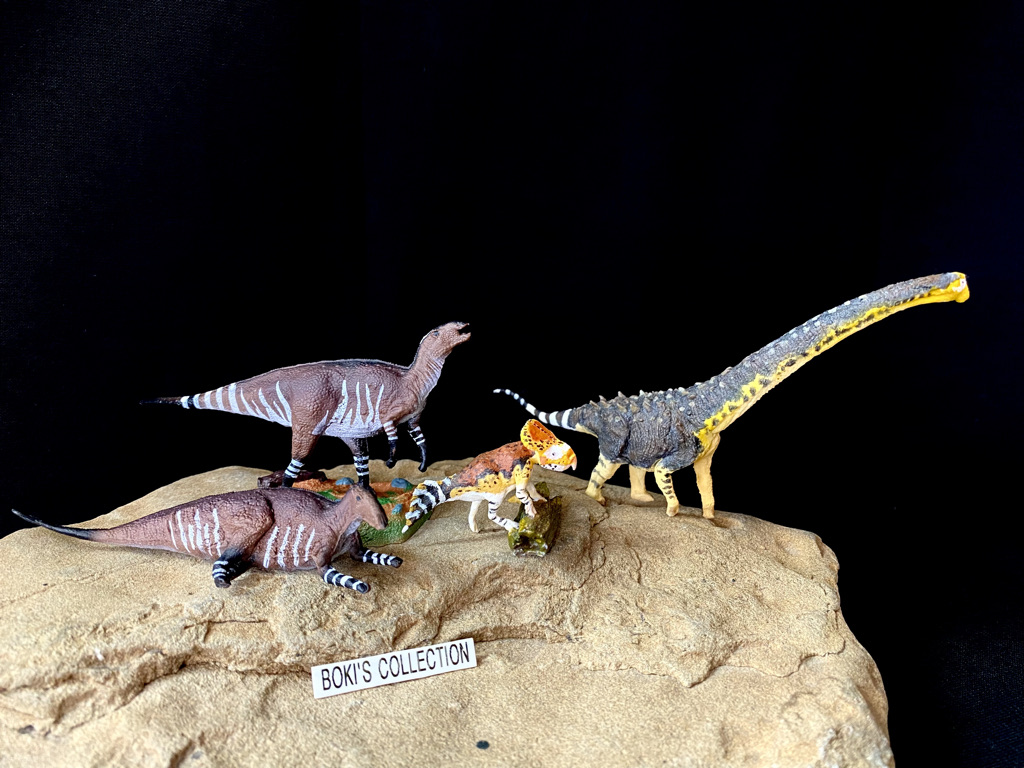
The figure captures all these features very well and shows just how much research was put into creating this model. The body follows the typical hadrosaur shape with a short neck, powerful tail, longer hind limbs while those on the front are shorter. Its limbs are gracile and slender.The pair are posed differently with one standing and one reclining, and shows some difference in their color scheme that could be interpreted as sexual dimorphism or difference in age, the choice is yours, the flexibility is a nice bonus. As a 1:30 scale the figures are small so keep this in mind as we look closer at the details.
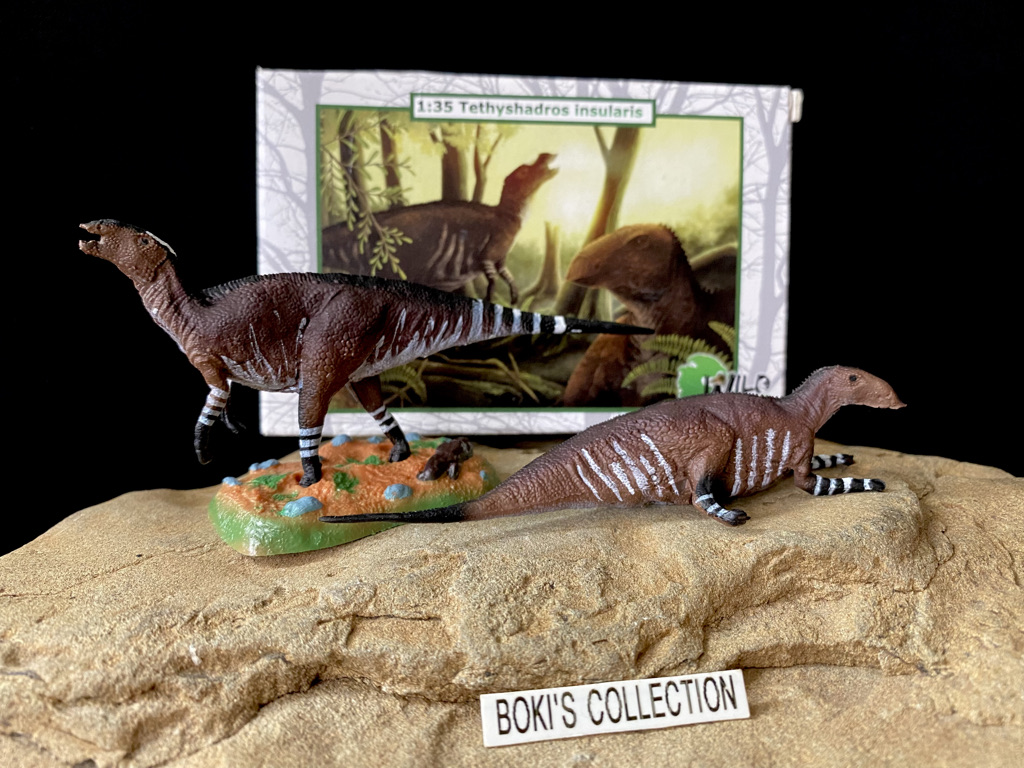
In addition, there is also a small diorama base that comes with the pair for the one that is standing to be attached to. The entire set is packaged in a nice small white box with the one side featuring the beautiful artwork of artist Joseph Fells showing the pair in a forest setting, the sides contain information about the dinosaur as well as the company.
Standing figure – This one is posed more like your typical hadrosaur: standing up biped in a slightly neutral stance. There is a bit of a motion on how its neck is slightly pulled back, its head raised and mouth open as if calling or just broadcasting its presence. This figure can stand (surprisingly given just how small those feet are!) without the base but is not stable as its feet are very small so you really need it. The feet insert into a set of footprints on the base (note: you may need to glue it to keep it in place, if not, the feet tend to pull off and the figure falls. This figure measure 4.4″ inches long and 2″ inches tall.
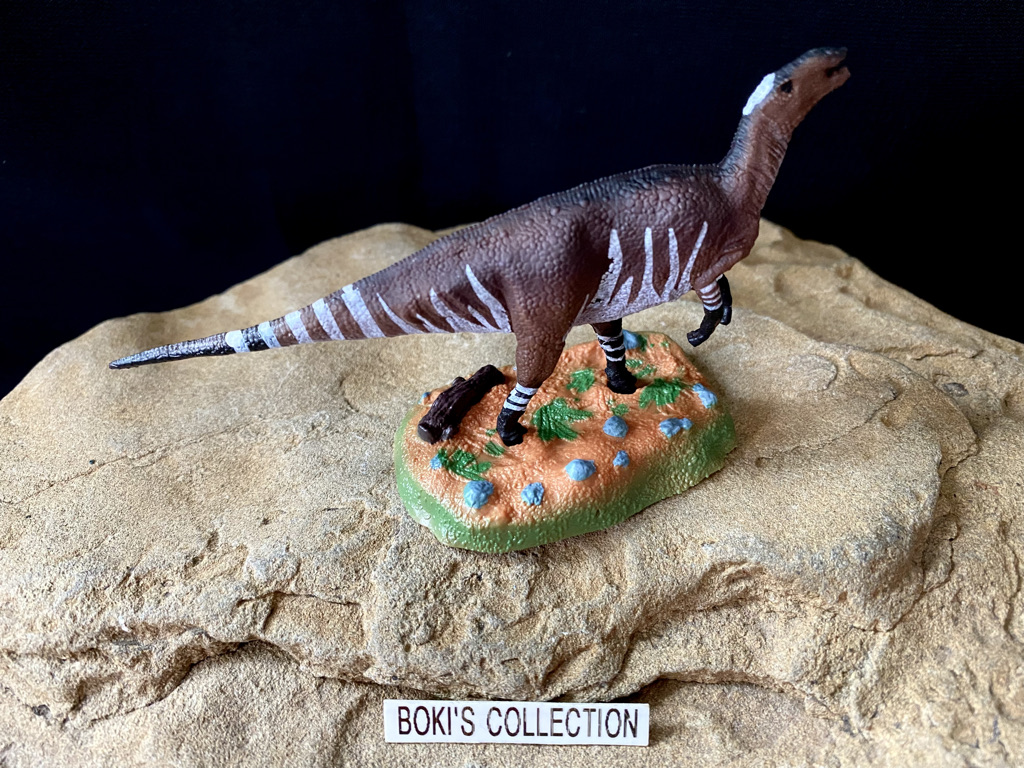
Reclining figure – This one is more unique in its pose. Resting dinosaur figures are rare with only a handful out there, so it’s refreshing to get one in this pose. Unlike the standing one, this is completely relaxed with both front and hind limbs resting on the ground. Its head is help up in a neutral position and it has its mouth closed.It measures the same as the standing one but is shorter due to the pose.

Base diorama – This is a small base that only fits the standing figure. It looks like a dry rocky mound with a few plants that are clearly trampled down by the animal. there is also a small log on one side. The base has lots of textures on it and in the center, you see the two footprints where the feet insert into. This base measure 2.25″ inches long and 1″ inch wide, so it is small and can only accommodate one figure.
The details on both figures are really nicely done and despite its small size, can be easily appreciated. On the head, you see small scales on the checks and snout and you can also see slightly bigger and raised ones that encircles the eyes.The beak is defined and even has groves, and on the figure with an open mouth, you can see a very small tongue barely visible ( you may need a magnifying glass to really see it), the nostrils on both are also visible – all of these features are very delicately sculpted. The eyes are small and are painted black (more on this later).
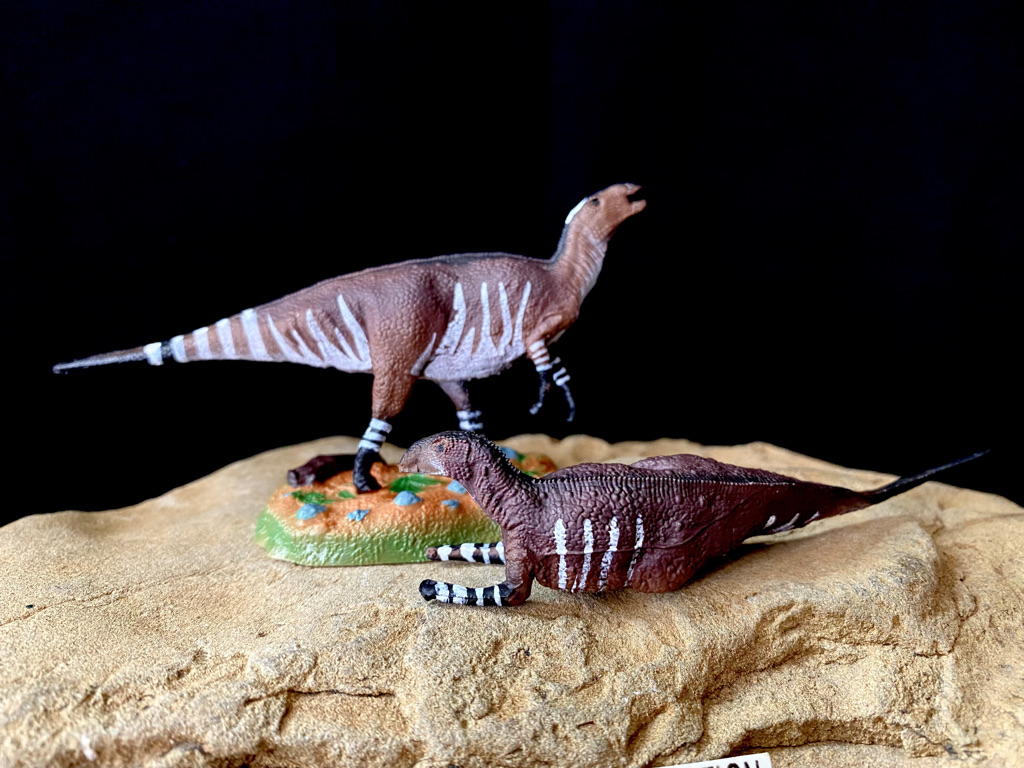
As you move down the neck you see plenty of skin wrinkles and lines especially on the throat area. There are good muscle definitions on the neck that captures motion and tension of the flesh and skin as the neck turns slightly.Beginning at the base of the skull, a small single row of delicate dorsal spines run down the entire length of the body all the way down to the tail.
The body is covered in hexagon-shaped scales of various sizes with the largest ones found on the back and hip region. Now, some of you may say the scales are too big. They may be slightly exaggerated, sure, but that is the only way you can show and transfer some of these details in a figure this small. Keeping the figure’s size in mind, anything smaller will be completely lost and you end up with a figure that is just smooth. In addition, you can see larger osteoderms scattered along the body. For their small size, these details are remarkably crisp.

Both figures show good musculature on the body with well-rounded torso. You can see skin folds in areas that you should expect to see them like around the armpits and stomach. The tail is well muscled especially the base as it should and taper off into a pointier end.The left leg of the resting figure is hidden under its body, but it can be seen when you turn it over. The standing one has its front legs held up, one leg slightly hinger than the other.The feet are small, correct shape ,and you can see the hoofed-like shape incorporated even at this small size.
The colors are striking and very reminiscing of the extant Okapi which I love. The base body colors are dark brown and black which varies in hues depending on which part. The lightest being on the sides of the body and slowly radiates outwards as it gets darker until the it reaches the back where it then transitions into black. The small dorsal spines are colored black as well. The last quarter length of the tail is also transition into black. The legs are given a black “stocking”.White stripes are seen on the sides of both figures although with a slight variation. The stripes and lack of it on one of the figure is a way to differentiate the two, you can treat it as sexual dimorphism or growth stages.
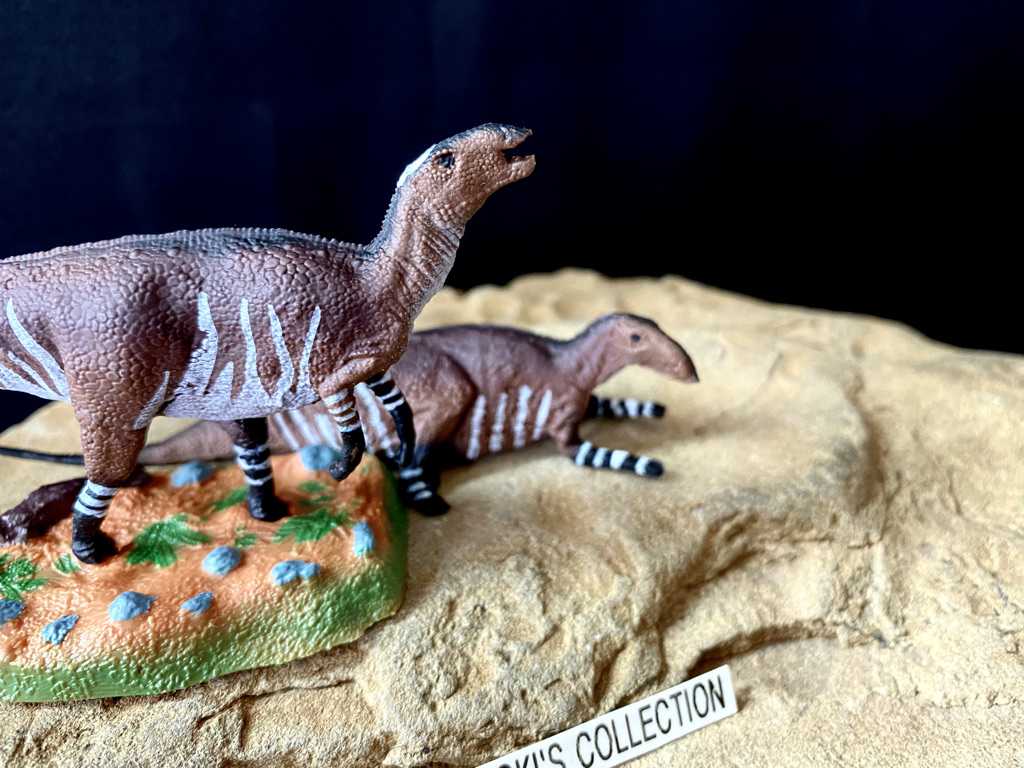
On the standing version, the white starts on the belly and slowly radiates upwards to the side before it breaks up into individual stripes as it travels up midway before terminating into sharp points. These stripes then turn into bands as it reaches the tail. A white patch is seen on the forehead as well as on the throat, the legs are also given white bands.
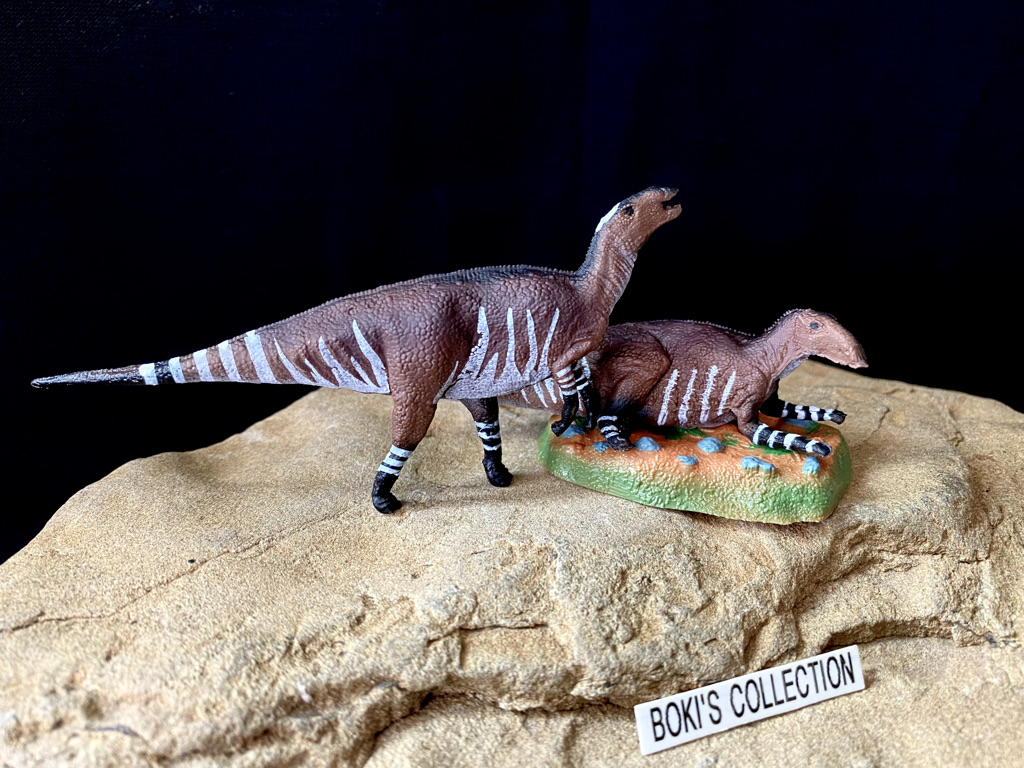
The resting figure has the same body colors; however, it lacks the white patch on the forehead seen on the standing one. The white stripe on the body is also different, while on the standing version the stripes start from the belly and moves upwards, on this version these stripes don’t. Instead, these stripes “float” on either side of the body. It also lacks the tail bands on the tail but does have them on the legs.


The one area that has suffered is in the paint application, more specifically in the way the white stripes are painted on. On the standing figure, the right side’s stripes are fine, but on the left side, the stripes looks like it came off leaving just a very faint outline.The resting figure suffered the most. The white stripes besides looking like they just float, also suffered from the paint bleeding. I think the problem is that the paint was too watered-down that when applied, it started to seep into the minute lines creating a “feathering” effect like what you see with watercolor on wet paper.


The eyes suffered the same problem; it’s very small so when the black dot was put on, it grew bigger in size as it spread into the surrounding area to the point that it looked like empty eye sockets!
I absolutely love the entire color scheme of the figure and really wanted to try and restore it to the original concept ( I saw some photos of the color mockup in an online interview of the artist) as closely as possible, as well as to try and bring out some of the amazing details that were obscured by the paint.So, on the standing figure, I cleaned up the lines and on the missing side, completely repainted the stripes. I also redid the white patch on the forehead by dry-brushing it since the original was a bit too thick.On the resting figure, I redid the white lines completely. I gave the white lines on the sides an “anchor” by making it radiate upwards from the stomach as well as adding some curvature.
As for the eyes, it was a struggle. I managed to do a small black dot that fits the sculpted eye, but it was so small it vanishes completely even just from a few inches distance. So, I decided to make them stand out by making them gold that contrasted with the dark color. I also dry-brushed a lighter shade of the brown to bring out all the wonderful details on the body.
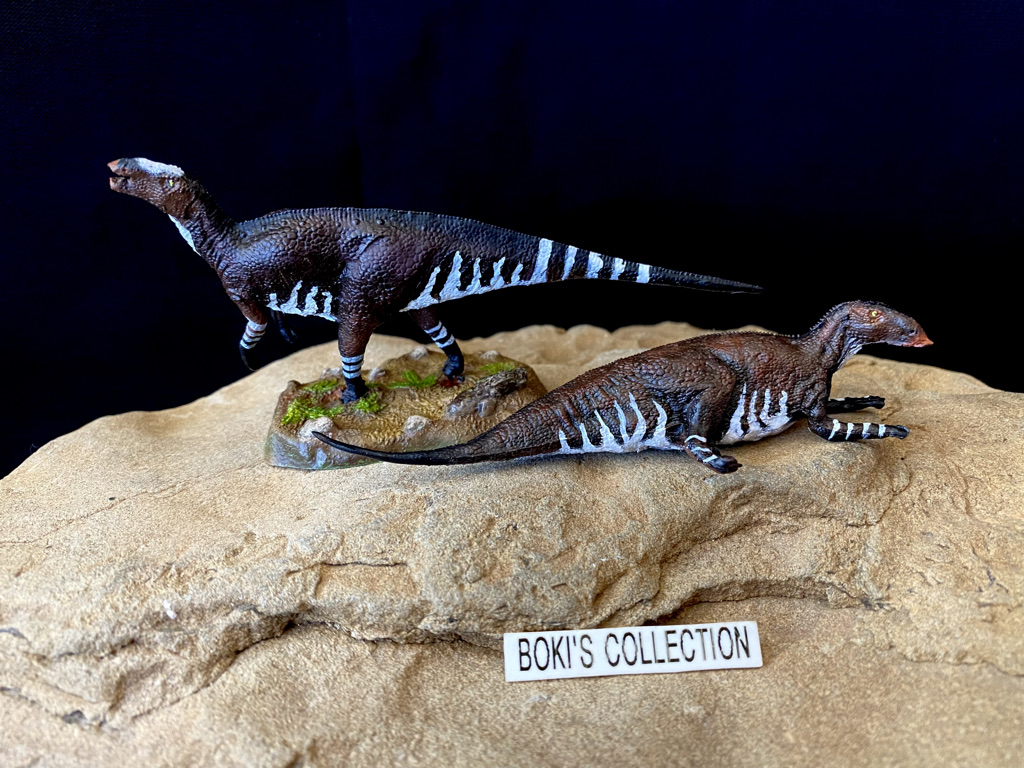
The base suffered too much color saturation especially the rocks. I understand that on mass produced figures, it’s difficult and not economical to put on so much painted details without increasing the price. So, this is the one piece of the set where I pretty much repainted the entire thing different from the original by using a whole different set of colors. I’m pretty happy how it all turned out and hopefully I did the entire set justice.
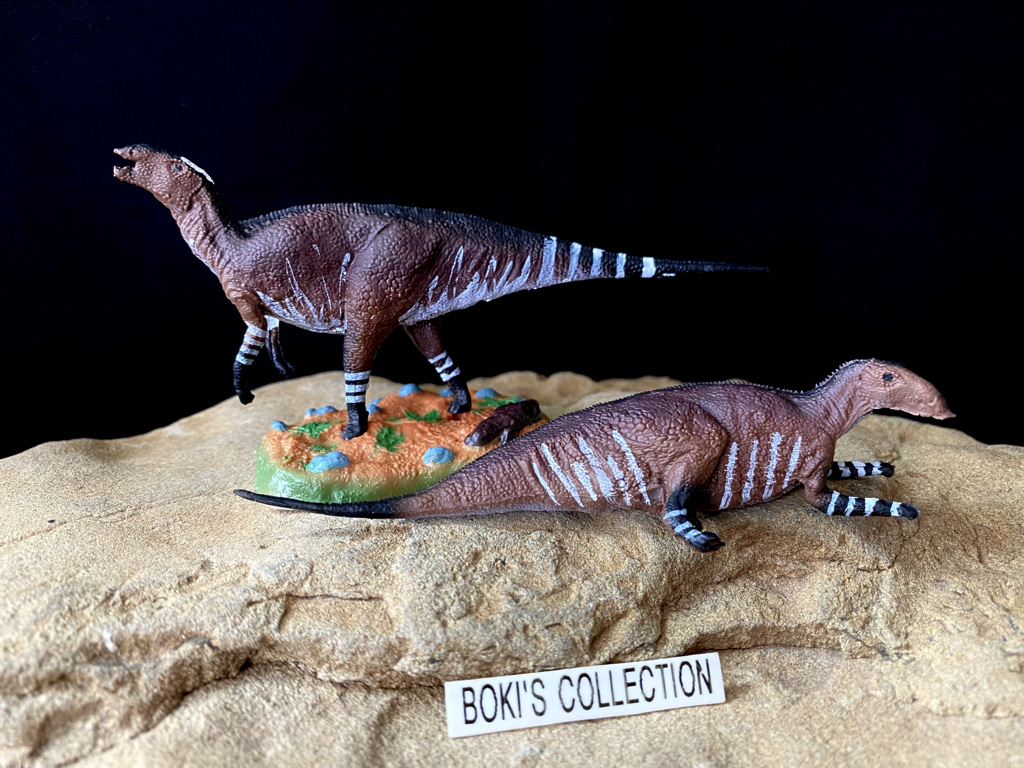
Overall, this set is a wonderful work of art and truly a labor of love. The pair, despite their small size would look nice in any display and can hold up against figures from other brands in terms of quality and visual appeal, plus the 1:35 scale would fit in nicely with many collections. Only having them in your hands can you really appreciate just how much details there really are on the figures, a testament to how much effort and research, not to mention talent the artist put into producing these delightful figures.
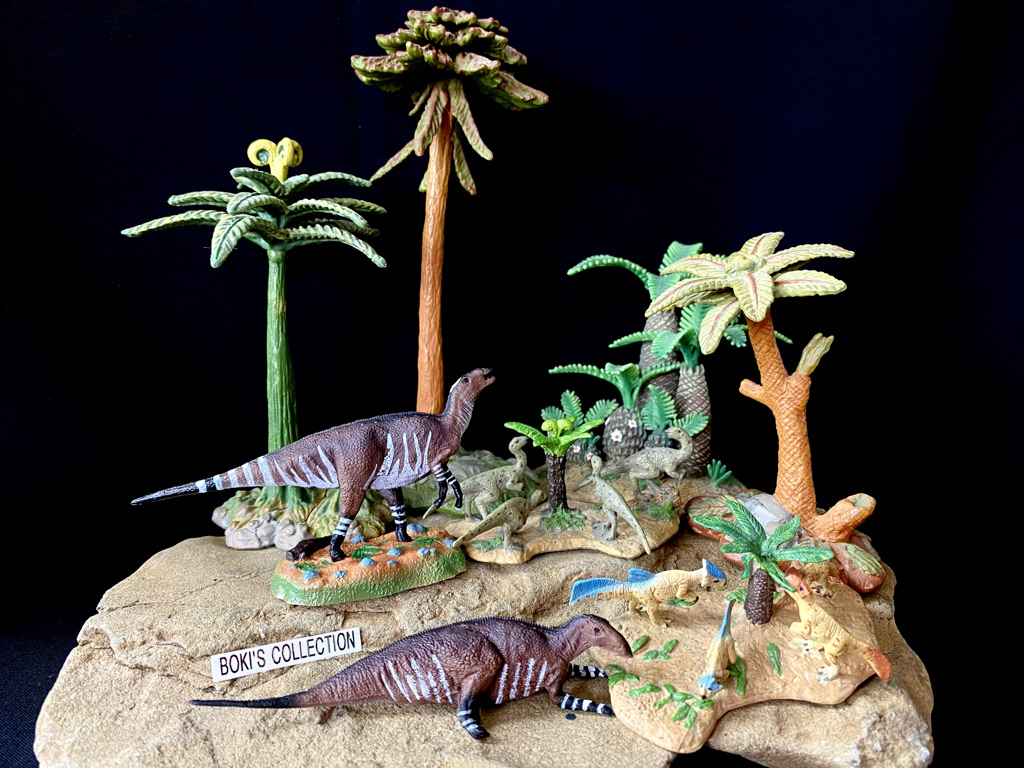
Most importantly, purchasing these pair (and the Protoceratops and others from Shapeways, too) would help support this fledgling brand and encourage Wild Past’s artist to continue producing excellent prehistoric figures. Already, some prototype figures of future offerings are showing great promise that should excite the collector community. It also allows the company to add more talented artist to their team. I wish Stefan and the whole Wild Past team the very best and looking forward to more figures from them.
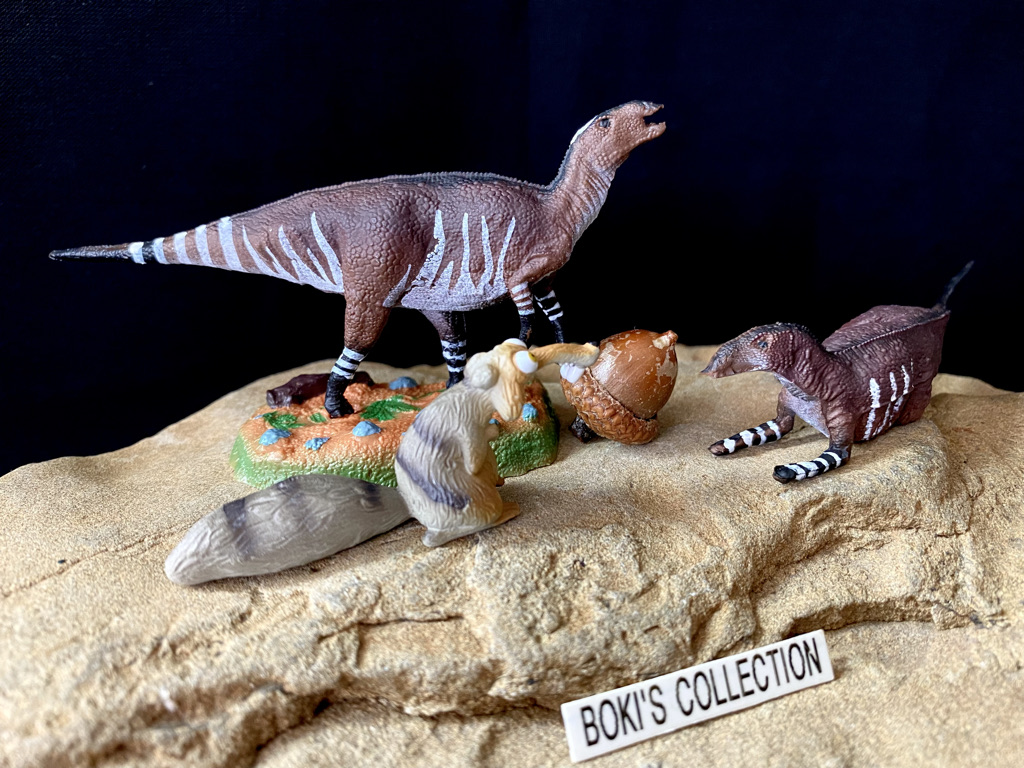
That concludes our review, hope you all enjoyed it and thanks for reading. Until the next one, stay healthy and keep safe. Cheers!
Disclaimer: links to Ebay and Amazon on the DinoToyBlog are affiliate links, so we make a small commission if you use them. Thanks for supporting us!




Marvelous figures and visionary for including a unrepresented genus, and a
reclining pose. Only the second company to ever produce a mated pair.
I do appreciate the smaller scale, yet admittedly some details are understandably lost.
Many in the community would welcome a larger scale for displaying alongside my other hadrosaur figures.
Honestly, they are very detailed figures despite their size and they are beautifully painted inspired by the okapi that for me is also a very dear animal.
On the other hand Boki the repainting work of both figures is great. Superb and extensive review and good photo credit.
I like the sculpts, but, though I thought well of the overall concept behind the painting, the application leaves a lot to be desired. You did an excellent job with your repaint – brings out the original intent of the artist. Same with the base.
I agree about the paint application, maybe future models will have better application so as not to distract from the amazing models.
These are great little figures. Mine falls off its base too, so I do what I usually do in these situations: make sure it has a plant nearby to lean on.